dogon
︎Culture, Spirituality, Symbolism, Article
︎ Ventral Is Golden
dogon
︎Culture, Spirituality, Symbolism, Article
︎ Ventral Is Golden
︎ Ventral Is Golden
Beneath the ocean a stream of consciousness,
above the Earth a cloud of thoughts.
The Dogon are one of the oldest-known living tribes whose mythological and cosmological lore has not only remained unchanged for thousands of years but also exhibits an understanding of complex quantum processes relating to the development of consciousness and the formation of matter.
above the Earth a cloud of thoughts.
The Dogon are one of the oldest-known living tribes whose mythological and cosmological lore has not only remained unchanged for thousands of years but also exhibits an understanding of complex quantum processes relating to the development of consciousness and the formation of matter.

For as long as humans have walked the Earth, they have looked up with curiosity, fear and reverence towards the night sky, imagining the contents of their psyche unfurl through heavenly spheres, held together by unfathomable worlds that lie beyond our ordinary perception. From this point, the conscious process of cognising humanity’s position and role within the universe began, mingling the contents of the psyche with the light from the most distant stars to inform the actions of all societies on Earth.
Later to be contained within the hermetic maxim of ‘as above, so below’, the idea of consciouness as a total field of awareness combined folk sciences with agriculture and a complex astrolgocial lore that gave rise to a celestial measure of time.
It is safe to assume that humanity had already developed sophisitcated methods of dividing space and time by 3000BC, when the first written texts of the Sumerian Sky-Watchers appeared and the initial seven planets of classical astronomy were observed in relation to deities and the influences they had upon the universe. Within Mesopotamia, the later Babylonians, flourishing from 1800BC, were considered the first great astronomers, although they were using knowledge transmitted via the earlier Sumerians.
The minutes and seconds of modern astronomical measurement derive from the Babylonian number system, and it was during this era that they introduced the useful concept of dividing the sky into twelve equal segments, defined by constellations through which the sun, moon and five fixed planets of classical astrology passed.
It was the Zodiac (’zodiakos kyklos’, meaning ‘animal circle’ in ancient Greek) that gave time its particular seasonal attributes in relation to observing both the earthly and wider cosmic envionments, often times with animal classes being the intermediaries between both realms.
In a modern context, the way of thinking about space and time is inherited through more moralistic and reductionist traditions that severed the earth’s connection to the cosmos through systematic desctruction of astrological texts. Subsequently there is a tendancy to project psyche outwards and to forget to look directly under our own feet, into the Mundus Subterraneus – the Inner Earth, both as the counterpoint to the material world, and as a possible dynamical influence that binds and affects the fluid dynamics of nature with consciousness.
Later to be contained within the hermetic maxim of ‘as above, so below’, the idea of consciouness as a total field of awareness combined folk sciences with agriculture and a complex astrolgocial lore that gave rise to a celestial measure of time.
It is safe to assume that humanity had already developed sophisitcated methods of dividing space and time by 3000BC, when the first written texts of the Sumerian Sky-Watchers appeared and the initial seven planets of classical astronomy were observed in relation to deities and the influences they had upon the universe. Within Mesopotamia, the later Babylonians, flourishing from 1800BC, were considered the first great astronomers, although they were using knowledge transmitted via the earlier Sumerians.
The minutes and seconds of modern astronomical measurement derive from the Babylonian number system, and it was during this era that they introduced the useful concept of dividing the sky into twelve equal segments, defined by constellations through which the sun, moon and five fixed planets of classical astrology passed.
It was the Zodiac (’zodiakos kyklos’, meaning ‘animal circle’ in ancient Greek) that gave time its particular seasonal attributes in relation to observing both the earthly and wider cosmic envionments, often times with animal classes being the intermediaries between both realms.
In a modern context, the way of thinking about space and time is inherited through more moralistic and reductionist traditions that severed the earth’s connection to the cosmos through systematic desctruction of astrological texts. Subsequently there is a tendancy to project psyche outwards and to forget to look directly under our own feet, into the Mundus Subterraneus – the Inner Earth, both as the counterpoint to the material world, and as a possible dynamical influence that binds and affects the fluid dynamics of nature with consciousness.
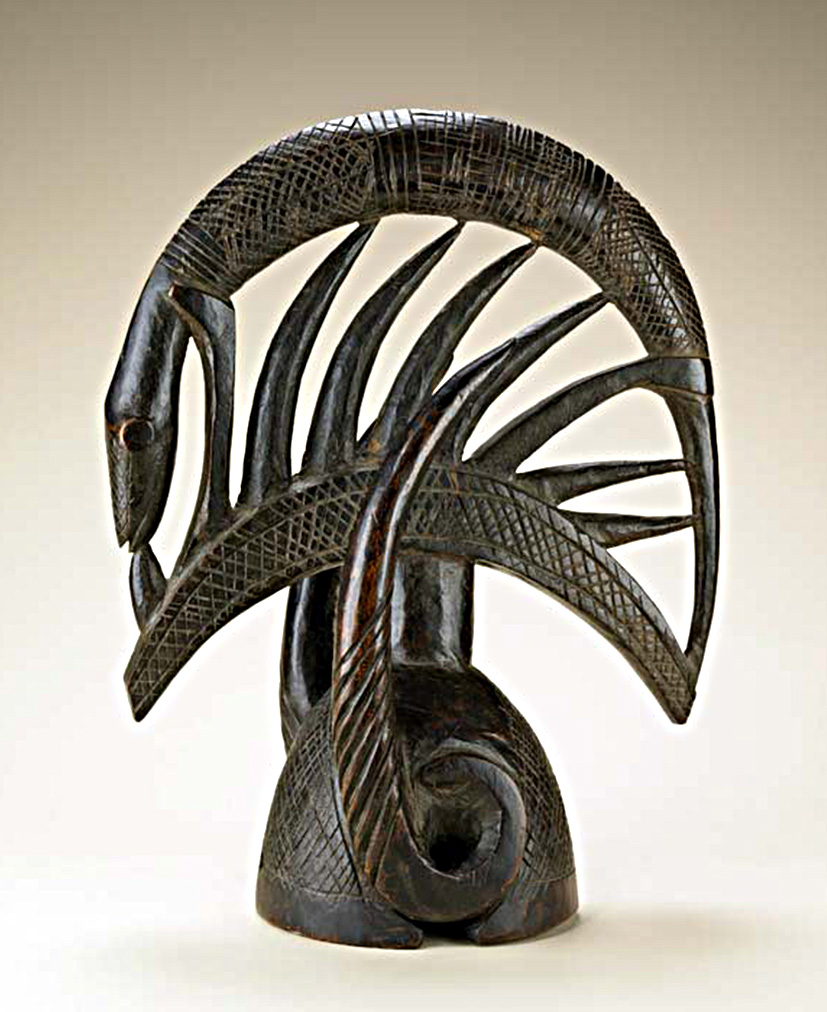
︎ Dogon sculpture.
.
︎ Dogon house.
If we think of the evolution of human consciousness as being a result of two overlapping spheres of influence acting upon each other, one from inside the Earth and the other from outer space, then the previously mentioned alchemical maxim ‘as above, so below’ starts to take on a geometric form. This form is considered fundamental in the geometry of sacred geometry, as seen in all ancient cultures.
Known as the Vesica Piscis (fish bladder), Mandorla (Almond) or as a ‘Bridge of Transcendence’, this shape – which consists of two equal circles passing through each other’s centre – represents the womb of consciousness as it emerges from the non-material realm and into the material realm, enabling the capacity of creation and self reflection.
Not only is this geometry found in cell division (and known in esoteric circles as the seed of life), its shape is a good visual aid to help us understand how consciousness could develop from two opposing forces that make up the particle and wave-like dynamics of quantum reality. In a mythological narrative, it can be found in the world-wide concept of the divine twins, and in less-mythical terms, it can simply be understood as the combined effects of electricity and magnetism.
![]()
Known as the Vesica Piscis (fish bladder), Mandorla (Almond) or as a ‘Bridge of Transcendence’, this shape – which consists of two equal circles passing through each other’s centre – represents the womb of consciousness as it emerges from the non-material realm and into the material realm, enabling the capacity of creation and self reflection.
Not only is this geometry found in cell division (and known in esoteric circles as the seed of life), its shape is a good visual aid to help us understand how consciousness could develop from two opposing forces that make up the particle and wave-like dynamics of quantum reality. In a mythological narrative, it can be found in the world-wide concept of the divine twins, and in less-mythical terms, it can simply be understood as the combined effects of electricity and magnetism.
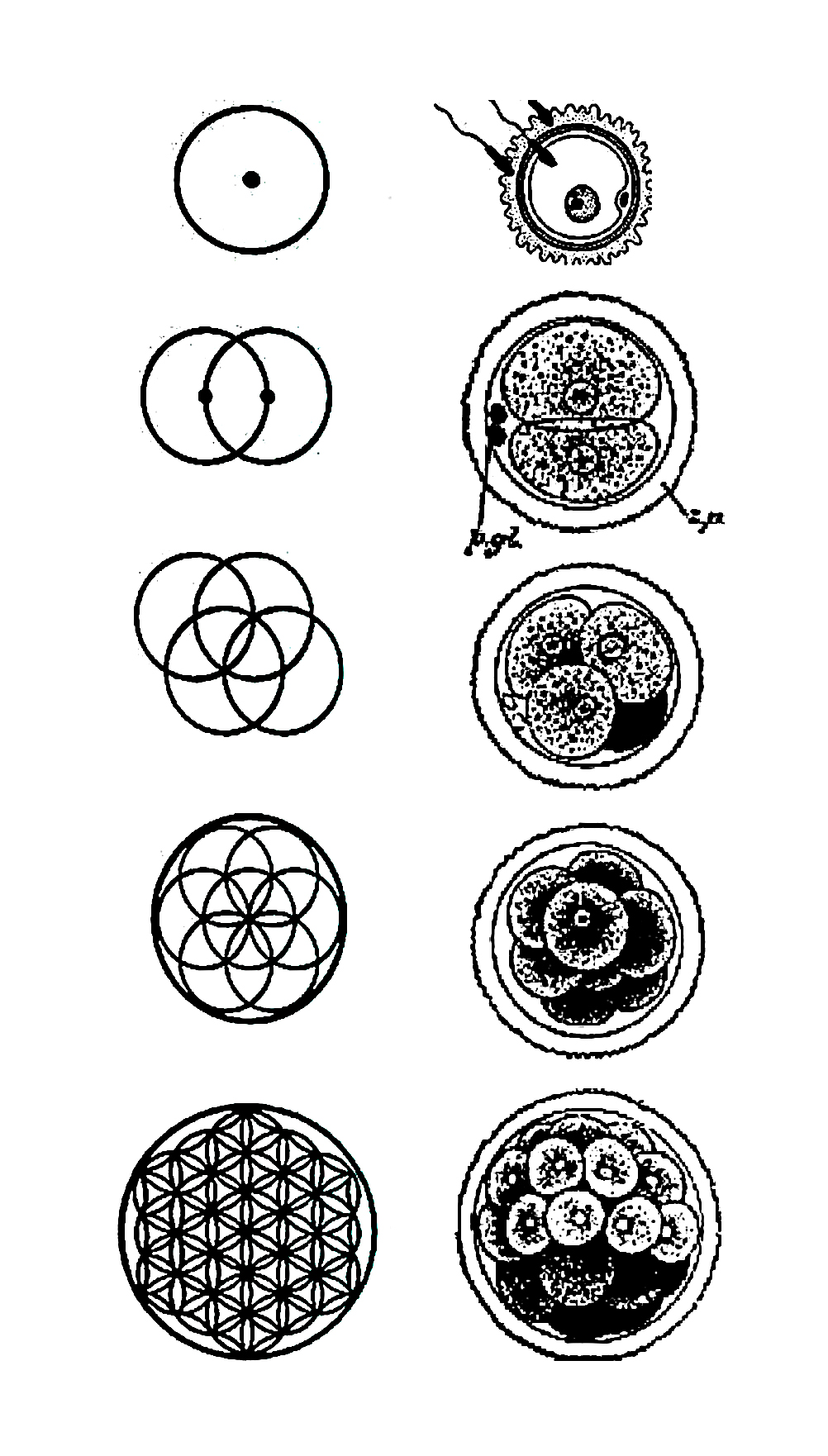
︎ Cell division & the seed, flower, fruit of life geometry.

︎ Edmond Halley‘s diagram of Inner Earth (1692).
Vesica Piscis geometry from Glastonbury, UK.
Vesica Piscis geometry from Glastonbury, UK.
An indigenous group in western Africa, known as the Dogon, is said to have preserved this sacred knowledge of geometry in its most original form by embodying it in their cultural practices. The Dogon, who have resisted various attempts to assimilate their culture into Islam, are one of the oldest-known living tribes whose cosmological and astrological knowledge have remained unchanged for thousands of years.
Through the extensive work of author Laird Scranton, it is now being understood that the Dogon’s cosmology is a collection of scientific concepts that exist throughout numerous cultures in a fragmented form. These fragments, as viewed within the Dogon culture, demonstrate sequential understanding of how matter forms from a quantum level up to a macrocosmic level, with the Vesica Piscis and duality being central concepts in their philosophy of the forces at play within the natural world.
![]()
Through the extensive work of author Laird Scranton, it is now being understood that the Dogon’s cosmology is a collection of scientific concepts that exist throughout numerous cultures in a fragmented form. These fragments, as viewed within the Dogon culture, demonstrate sequential understanding of how matter forms from a quantum level up to a macrocosmic level, with the Vesica Piscis and duality being central concepts in their philosophy of the forces at play within the natural world.

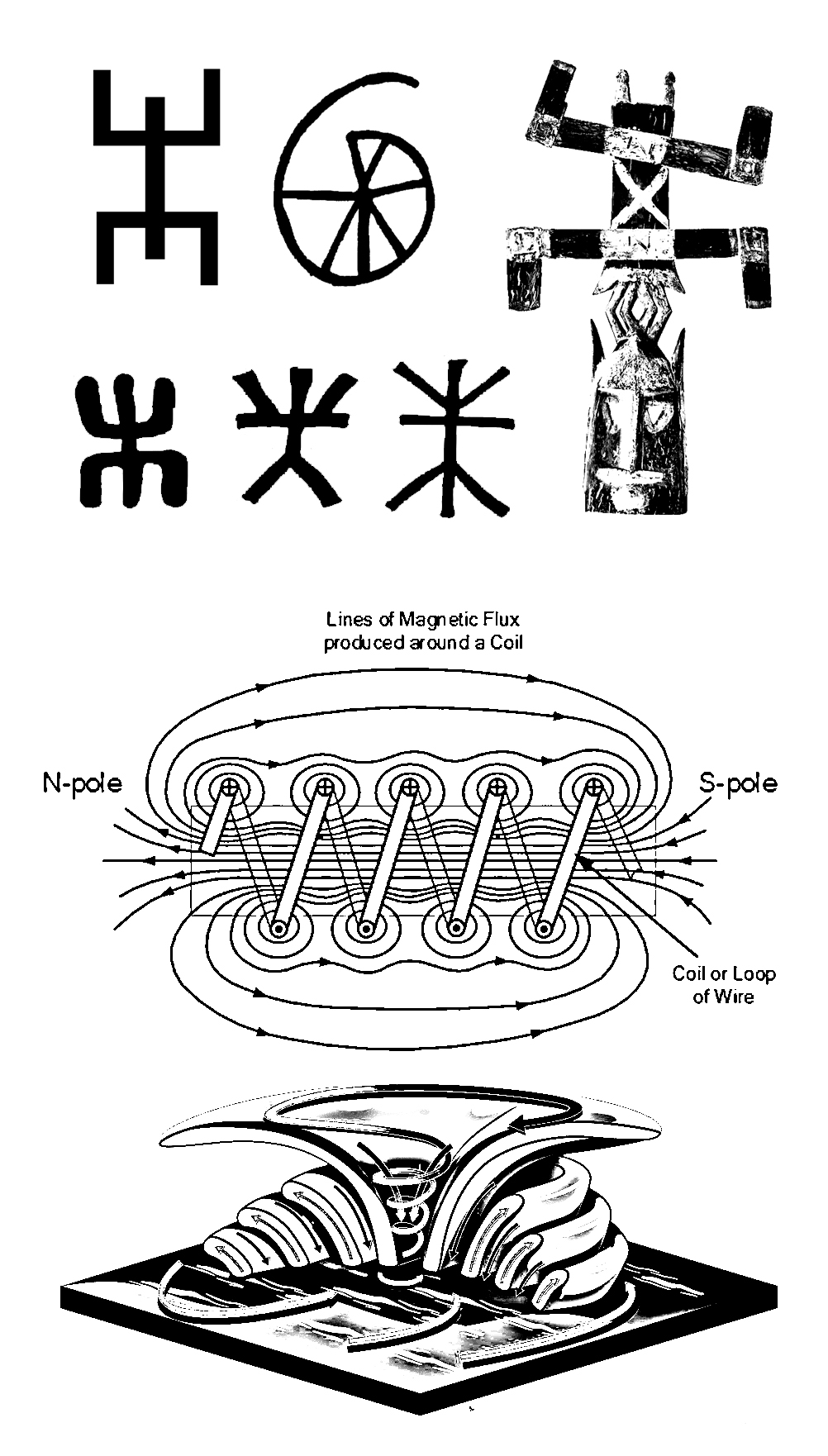
︎ Dogon symbolism alongside modern diagrams of electro-magnetism.
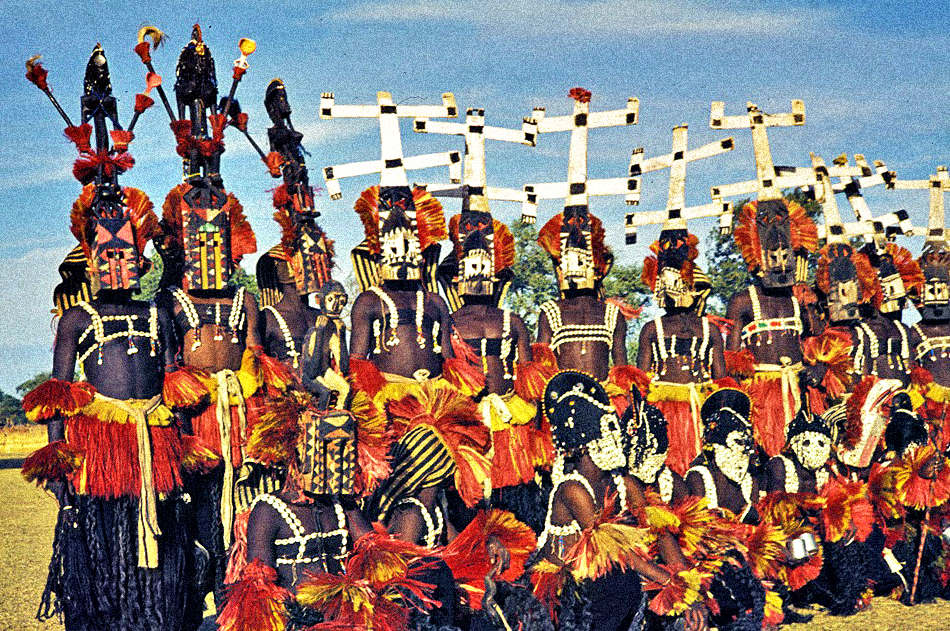
︎ Dogon tribesmen wearing the Kanaga mask, symbolising the connection between the seen and unseen aspects of the universe.
A central concept to Dogon cosmological lore is the idea of the twin and the resurrection, which is echoed in all later traditions from the Indus Valley through to Mexico. This concept illustrates that the nature of reality is fundamentally dualistic and negentropic, in the same sense that a photon (the smallest unit of light) can exhibit properties of both waves and particles, and that the solar system tends towards a state of order from a state of disorder. To explain this, the Dogon speak of the divine twins called Nommo, who were born of Amma and Ogo.
Amma is the principal deity or force of creation. A hermaphroditic god (hermaphrodite being a combination of Hermes and Aphrodite – a messenger of love and knowledge), who’s name shares the same root as the Egyptian and Semitic word ‘Amen’ said at the end of a prayer, meaning ‘to make firm, to establish, to fortify.’
Both Amma and Ogo are known to have existed inside a cosmic egg, which the Dogon refer to as an ‘accelerated ball’. This egg, also known as ‘The Womb of All World Signs’, contained all the seeds and symbols necessary to generate existence. The force of Amma is conceptualised as a voice or vibration that spoke seven words into a seed called a ‘Po’, which represents an atom as well as a black hole.
These seven words created a spiral of seven revolutions that broke the membrane of the cosmic egg on the eighth turn and scattered primordial matter across the universe, eventually forming the spiral arms of the Milky Way galaxy, known to the Dogon as the ‘Clavicles of Amma’. These signify the shape of the human collarbone, the first bones to form in the human body. The navel, birthplace or ‘omphalos’ of the galaxy, is called ‘Amma’s Navel’ (Amma Bolo Boy Tolo), and can be recognised in modern astrology as the spiral nebula of Orion – the birthplace of stars.
Amma is the principal deity or force of creation. A hermaphroditic god (hermaphrodite being a combination of Hermes and Aphrodite – a messenger of love and knowledge), who’s name shares the same root as the Egyptian and Semitic word ‘Amen’ said at the end of a prayer, meaning ‘to make firm, to establish, to fortify.’
Both Amma and Ogo are known to have existed inside a cosmic egg, which the Dogon refer to as an ‘accelerated ball’. This egg, also known as ‘The Womb of All World Signs’, contained all the seeds and symbols necessary to generate existence. The force of Amma is conceptualised as a voice or vibration that spoke seven words into a seed called a ‘Po’, which represents an atom as well as a black hole.
These seven words created a spiral of seven revolutions that broke the membrane of the cosmic egg on the eighth turn and scattered primordial matter across the universe, eventually forming the spiral arms of the Milky Way galaxy, known to the Dogon as the ‘Clavicles of Amma’. These signify the shape of the human collarbone, the first bones to form in the human body. The navel, birthplace or ‘omphalos’ of the galaxy, is called ‘Amma’s Navel’ (Amma Bolo Boy Tolo), and can be recognised in modern astrology as the spiral nebula of Orion – the birthplace of stars.
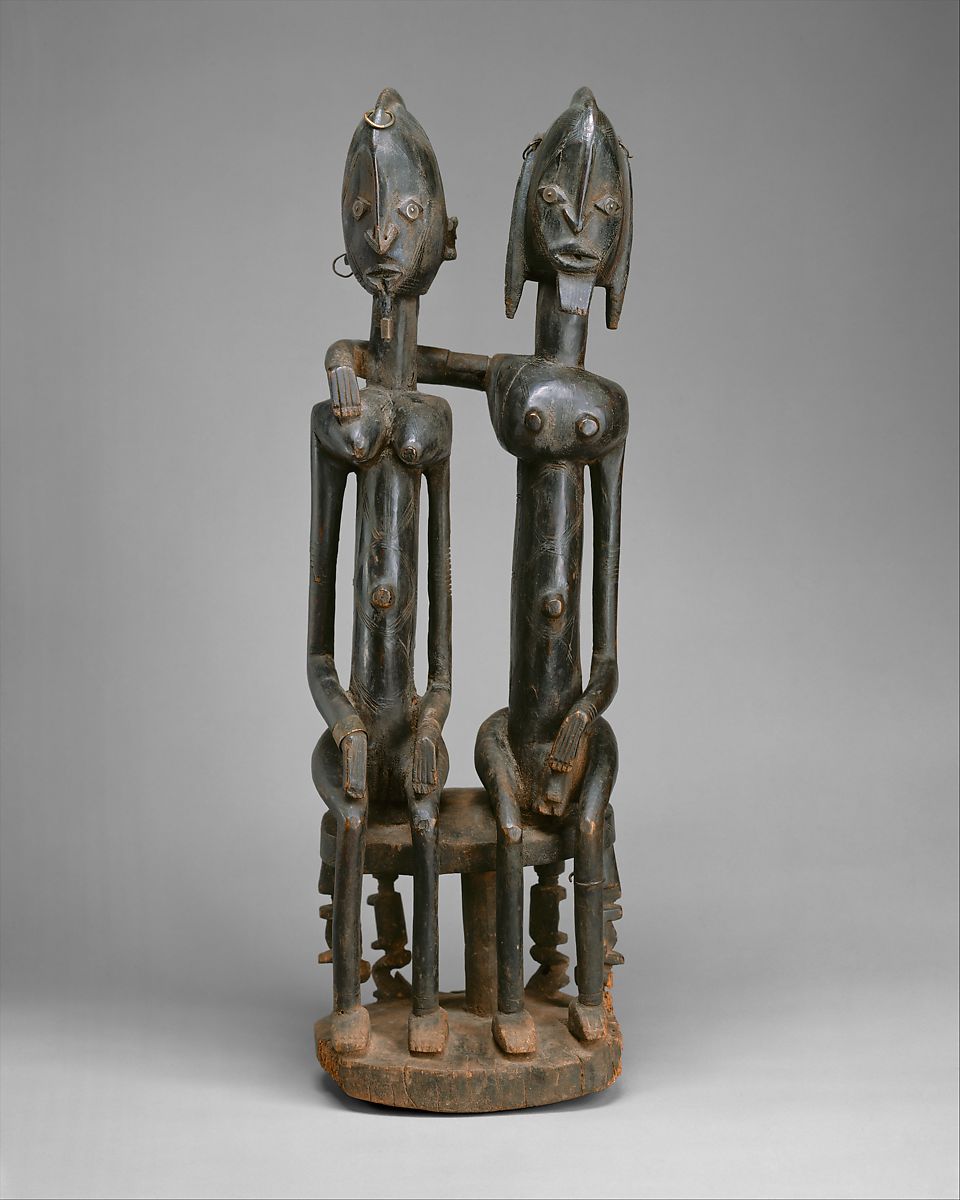
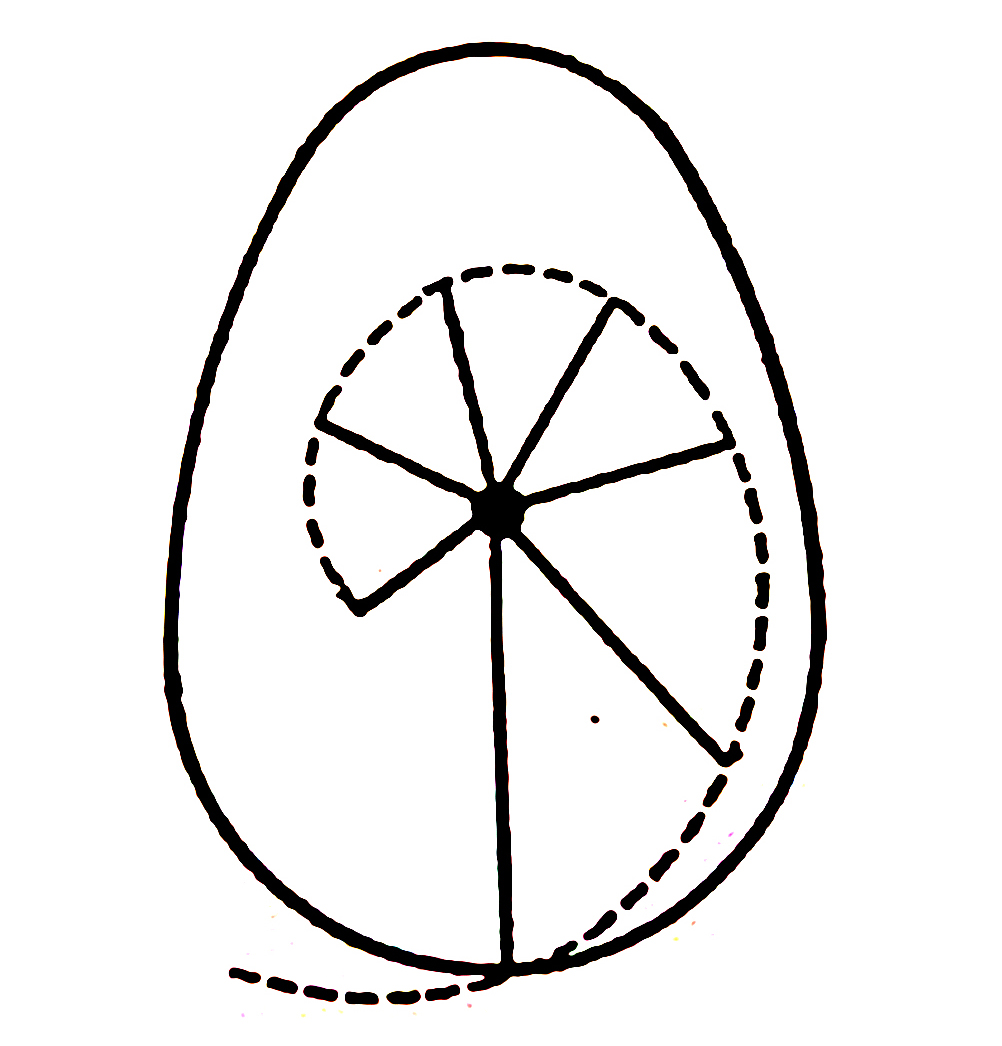
︎ The Cosmic Egg or Accellerated Ball, depicting the seven-spiralled descent of energy into matter.
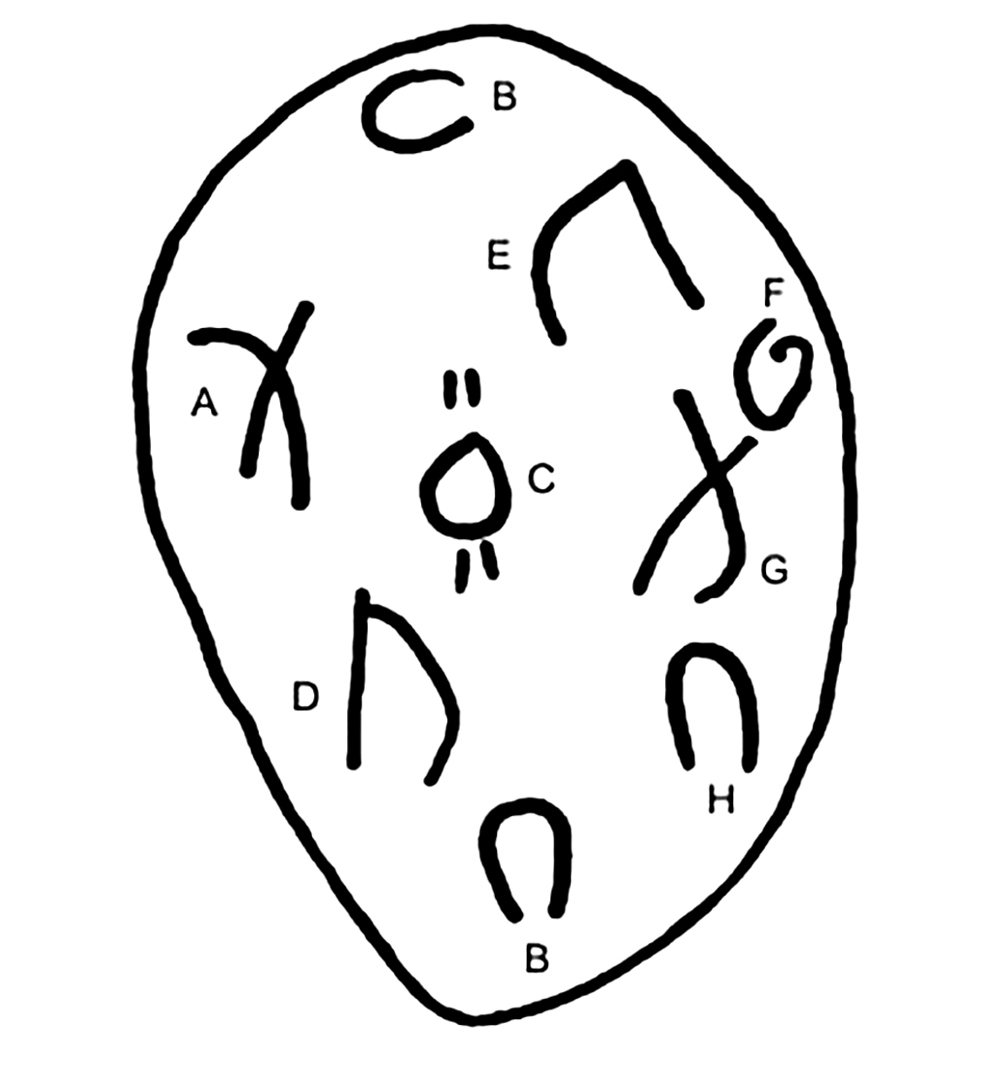 ︎ Egg of Amma (The Womb of All World Signs) Drawn by a Dogon high priest and presented by Marcel Griaule & Germaine Dieterlen.
︎ Egg of Amma (The Womb of All World Signs) Drawn by a Dogon high priest and presented by Marcel Griaule & Germaine Dieterlen.A: Sirius
B: Po Tolo
C: Emma Ya
D: The Nommo
E: Mythical Male
F: Star of Woman
G: Sign of Woman
H: Uterus
Just over eight light years from Earth, the solar system of Sirius (Sigi Tolo & Po Tolo) is where Ogo, a creation of Amma, broke free from the cosmic egg before he was fully formed. Ogo represents the trickster archetype of Jungian psychoanalysis, and is considered a chaotic force of light that disrupted the harmonic plan of Amma.
Ogo represents a volatile aspect of the early universe that relates in some way to the theory of relativity (space-time), photons and plasma as the universe cooled to form hydrogen and ultimately, water.
As in many myths, the chaotic aspect of the early universe is often presented as a snake that is eventually sacrificed to release water. In Greek mythology, the name Hydra is a reflection of the process of generating hydrogen, a fundamental element of water, thought to be the first atom the universe produced. Ogo is also sometimes described as a reptile, although Amma and Ogo are also seen as a pair of the first Nommo, considered the ancestors of all modern humans. In their true physical sense, the Nommo are described as part-fish, part-reptile and part human, although they also have a non-physical form.
Because of Ogo’s transgressive behaviour, he left the solar system of Sirius and descended to Earth, where he is said to have created our Sun, but because Ogo only represented half of creation (the masculine aspect), the solar system he created was unbalanced. And so he returned to Sirius in search of his female counterpart, but Amma refused, hiding her inside the third imperceptible star of Emma Ya Tolo (also named the Mother Guardian of the Feminine Essence), and instead made another perfected Nommo in her place, who was then immediately sacrificed.
The body of this divine Nommo spread across the universe, extending from Sirius to Earth via the Milky Way. This represented a sacred covenant between spirit and matter, the seen and unseen worlds that linked the forces of electricity and magnetism between our solar system and the system of Sirius.
Ogo was sent back to Earth and transformed into a pale fox, destined to roam the material realm, whilst from the body of the perfected Nommo, four pairs of new Nommo became the ancestor avatars of humanity.
The name ‘Nommo’ means ‘to make one drink’, but other terms translate it as ‘The Teachers’, ‘The Watchers’ and ’The Masters of Water’. Their mythology has survived in several cultures (namley as Oannes) from Sumeria, Greece, Egypt and Mexico. Their equivalent name in ancient Greek can be linked to the ‘pneuma’ (breath, spirit) and in ancient Egyptian evolved into the phrase ‘Nu Ma’ (primordial water / measure), which in modern English translates as ‘the perception of waves’.
Ogo represents a volatile aspect of the early universe that relates in some way to the theory of relativity (space-time), photons and plasma as the universe cooled to form hydrogen and ultimately, water.
As in many myths, the chaotic aspect of the early universe is often presented as a snake that is eventually sacrificed to release water. In Greek mythology, the name Hydra is a reflection of the process of generating hydrogen, a fundamental element of water, thought to be the first atom the universe produced. Ogo is also sometimes described as a reptile, although Amma and Ogo are also seen as a pair of the first Nommo, considered the ancestors of all modern humans. In their true physical sense, the Nommo are described as part-fish, part-reptile and part human, although they also have a non-physical form.
Because of Ogo’s transgressive behaviour, he left the solar system of Sirius and descended to Earth, where he is said to have created our Sun, but because Ogo only represented half of creation (the masculine aspect), the solar system he created was unbalanced. And so he returned to Sirius in search of his female counterpart, but Amma refused, hiding her inside the third imperceptible star of Emma Ya Tolo (also named the Mother Guardian of the Feminine Essence), and instead made another perfected Nommo in her place, who was then immediately sacrificed.
The body of this divine Nommo spread across the universe, extending from Sirius to Earth via the Milky Way. This represented a sacred covenant between spirit and matter, the seen and unseen worlds that linked the forces of electricity and magnetism between our solar system and the system of Sirius.
Ogo was sent back to Earth and transformed into a pale fox, destined to roam the material realm, whilst from the body of the perfected Nommo, four pairs of new Nommo became the ancestor avatars of humanity.
The name ‘Nommo’ means ‘to make one drink’, but other terms translate it as ‘The Teachers’, ‘The Watchers’ and ’The Masters of Water’. Their mythology has survived in several cultures (namley as Oannes) from Sumeria, Greece, Egypt and Mexico. Their equivalent name in ancient Greek can be linked to the ‘pneuma’ (breath, spirit) and in ancient Egyptian evolved into the phrase ‘Nu Ma’ (primordial water / measure), which in modern English translates as ‘the perception of waves’.
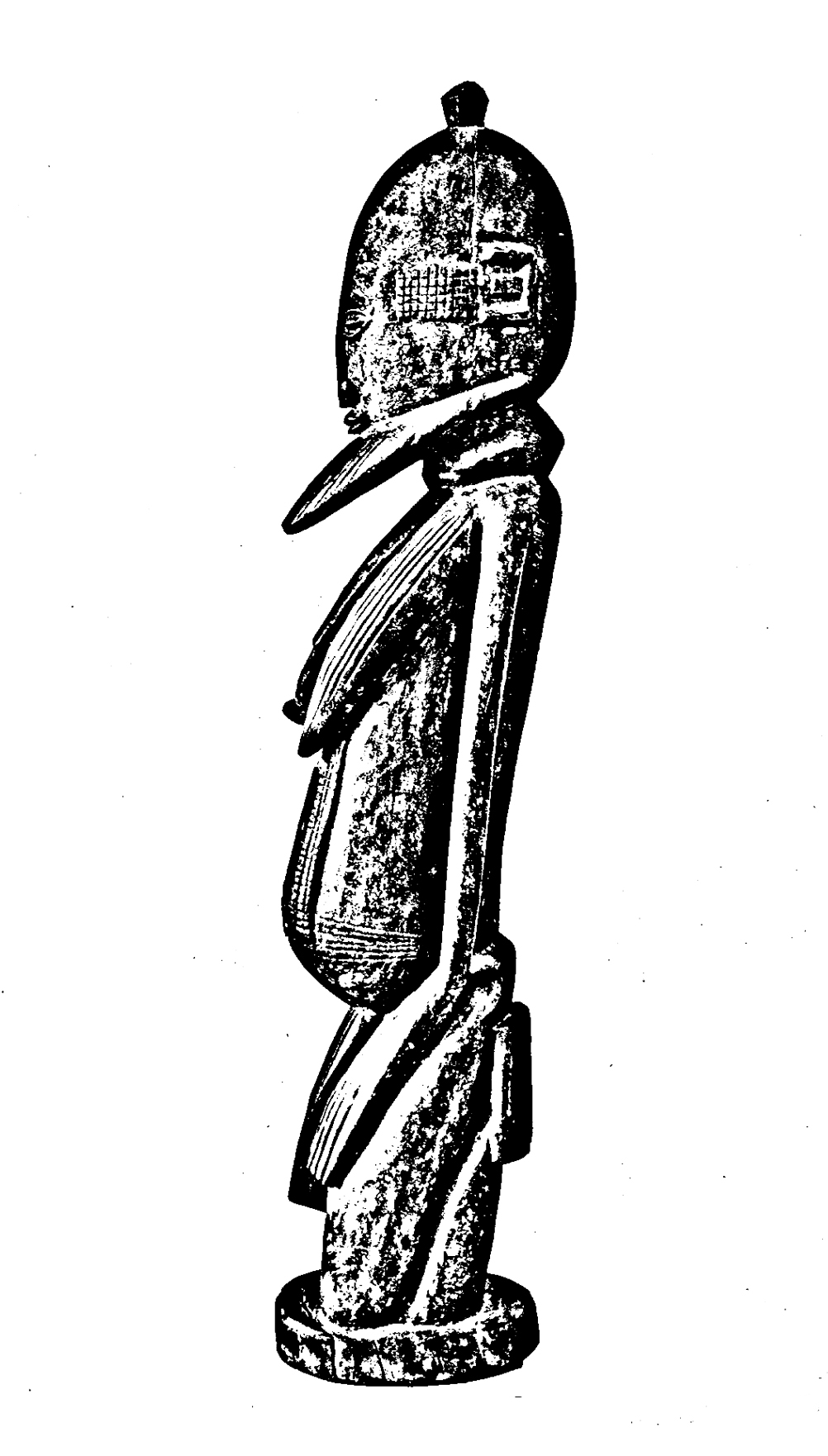
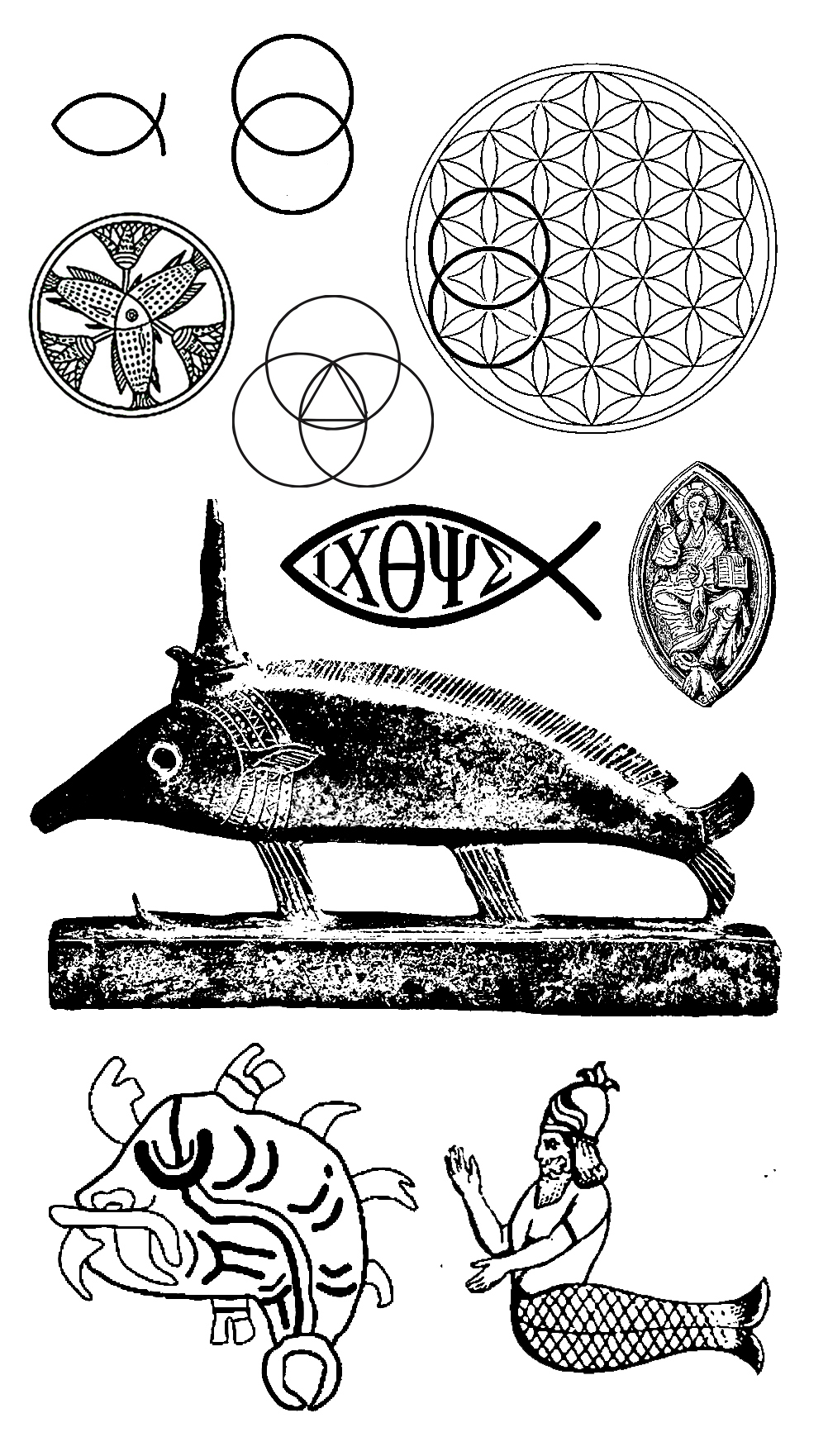
︎ Various cultural references of the mythologyical fish and its geometric counterpart.
Dogon cosmology is also particularly mysterious in that it presents knowledge of the Sirius star system and the spiral nebula of the Orion constellation, both unseen to the naked eye and unknown in the West until after the invention of the telescope, with Sirius B not being photographed until the 1970s. The Dogon also claim that the star system of Sirius is not binary as is currently understood, but actually has three stars – the third, named Emma Ya Tolo, is yet to be discovered by modern technology.
With no written language or access to telescopes, the Dogon theoretically shouldn’t know any of this information.
As there is often a tendency to project present-day scientific knowledge into the past, the well known astrologer Carl Sagan once remarked that the Dogon must have obtained their knowledge from a Western source. It should be made clear, however, that through the work of Scranton, supported by a 30-year anthropological study by Marcel Griaule and Germaine Dieterlen, he states the Dogon always convey their knowledge using their own definitions, originally given in a form of ancient Egyptian that went out of use before 700BC, ruling out any possibility that this knowledge came to them via a modern source.
The analogy between seen and unseen realms contained within the Dogon creation myth can be easilty visualised as two streams of energy that flow between a seen and unseen world, and the same wave dynamics can be measured on a physical plane when two pressure differentials overlap in our atmosphere. This effect is known as the weather, and it produces a wide array of effects from tidal movements to thunderclouds and plasma discharges in the Earth’s magnetosphere.
This process of energy transfer describes the geometry of the Vesica Piscis and also the proposed orbits of all the bodies relative to each other in the Sirius star system as viewed by the Dogon. It is around the third, as-yet-undiscovered star of Emma Ya Tolo, where the smaller satellite of Nylan Tolo (the Star of the Woman) can be found. It is from this satellite the Dogon believe the Nommo came to take up residency in the Earth’s ocean.
In scientific terms, the dual energy of the Nommo twins is an example of harmonic resonance, which at some point in the early stages of the universe became disrupted and somehow altered physical reality. At the quantum level, this dual energy spins around a centre to generate mass from an electromagnetic field, which can also be understood as resonance. This phenomena can be scaled to the size of a galaxy, and despite the changes in definition over the centuries that define terms in isolation to eachother, is still something that, as physical beings consisting mostly of water, we are intimately connected to.
With no written language or access to telescopes, the Dogon theoretically shouldn’t know any of this information.
As there is often a tendency to project present-day scientific knowledge into the past, the well known astrologer Carl Sagan once remarked that the Dogon must have obtained their knowledge from a Western source. It should be made clear, however, that through the work of Scranton, supported by a 30-year anthropological study by Marcel Griaule and Germaine Dieterlen, he states the Dogon always convey their knowledge using their own definitions, originally given in a form of ancient Egyptian that went out of use before 700BC, ruling out any possibility that this knowledge came to them via a modern source.
The analogy between seen and unseen realms contained within the Dogon creation myth can be easilty visualised as two streams of energy that flow between a seen and unseen world, and the same wave dynamics can be measured on a physical plane when two pressure differentials overlap in our atmosphere. This effect is known as the weather, and it produces a wide array of effects from tidal movements to thunderclouds and plasma discharges in the Earth’s magnetosphere.
This process of energy transfer describes the geometry of the Vesica Piscis and also the proposed orbits of all the bodies relative to each other in the Sirius star system as viewed by the Dogon. It is around the third, as-yet-undiscovered star of Emma Ya Tolo, where the smaller satellite of Nylan Tolo (the Star of the Woman) can be found. It is from this satellite the Dogon believe the Nommo came to take up residency in the Earth’s ocean.
In scientific terms, the dual energy of the Nommo twins is an example of harmonic resonance, which at some point in the early stages of the universe became disrupted and somehow altered physical reality. At the quantum level, this dual energy spins around a centre to generate mass from an electromagnetic field, which can also be understood as resonance. This phenomena can be scaled to the size of a galaxy, and despite the changes in definition over the centuries that define terms in isolation to eachother, is still something that, as physical beings consisting mostly of water, we are intimately connected to.
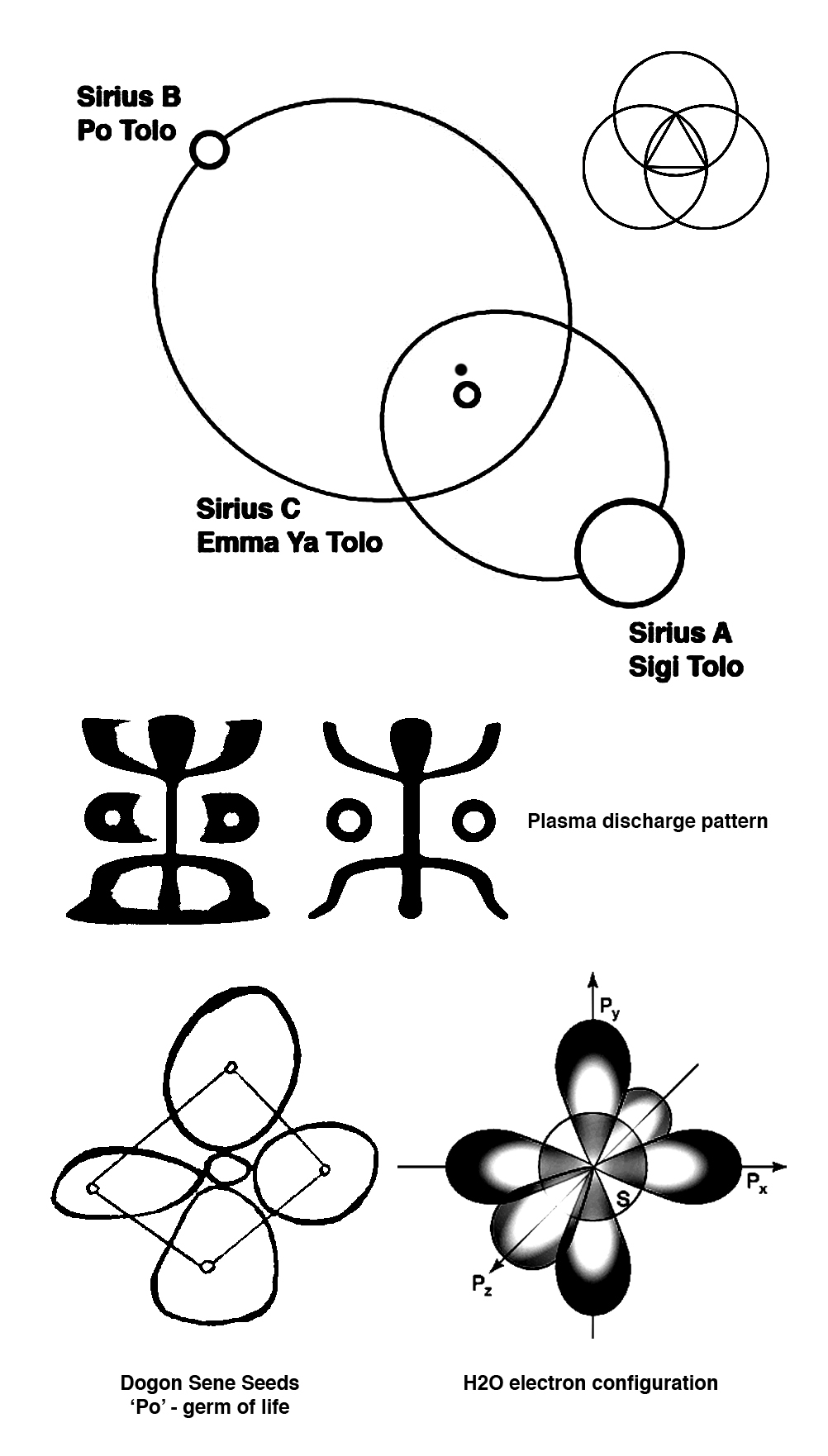
︎ Dogon names for ‘seed’ and ‘star’.
Kanaga symbol alognside modern diagrams of electron orbitals and theoretical plasma discharge pattern.
Kanaga symbol alognside modern diagrams of electron orbitals and theoretical plasma discharge pattern.
Many examples of the Nommo echo throughout ancient cultures and are thought to be the seed of traditions that extend into Sumerian mythology, which tells of the Apkallu – the eight, part fish and part human sages who transferred knowledge to humankind before a great flood.
The role of the Apkallu was to tell the creation story – the Enuma Elišh. This creation story mentions a goddess, a female prime mover who established Heaven and Earth, and gave birth to the first-generation of Mesopotamian gods. Her name is Nammu.
After mixing herself with a male principle called Apsu, who is seen as an underground sea of life-giving properties, Apsu then merges with the saltwater ocean called Tiamat, or ‘The Shining One’. Tiamat, who is also considered a chaotic serpentine principle of creation, was then sacrificed, and her body was scattered through the cosmos to create our solar system, in much the same way as the perfected Nommo of the Dogon was sacrificed. Through a sacred ‘mixing of the waters’ of Tiamat (the outer ocean) and Apsu (the inner ocean), their son Mummu, who represents speech and the word of creation, was formed.
It is interesting that Geophysicists are recently discovering the possibility, that 400 miles beneath the Earth’s surface is a Transition Zone, and here lies an ocean of water locked inside a rare mineral called Ringwoodite, thought to be only found in meteorites. Could this suggest that detailed knowledge of the geological formation of Earth was known to ancient cultures, and that the foci of their myths centred on preserving the memory of inter-dimensional entities who described the nature of the conscious universe to them in terms of the mixing of two oceans?
Just above the region of the Transition Zone, at around 150 miles below the Earth’s surface, are the deepest sections of tectonic plates. Thought to be inverted mountains called cratons, these may contain up to a quadrillion tonnes of crystal, which act as roots that anchor ancient land towards the Earth’s magnetic centre. Understanding their resonant properties will give more insight into the dynamics of Earth’s electro-magnetic field. As geophysicists are currently interpreting Earth’s inner core as behaving more like plasma than a solid or liquid, and its outer core to act like a dynamo that conducts electricity through an enormous forest of iron crystals, the drive of fluid dynamics through the magnetic field will change our perception of the Earth itself into a gigantic structure of resonance.
As incredibly accurate as the Dogon knowledge of geology, astrology and quantum physics seems to be, they amazingly don’t claim it as their own, but rather say that it was given to them by the Nommo, in a series of initiations on subjects relating to the civilising skills of architecture, astronomical alignment, art, dance, agriculture and written language.
The role of the Apkallu was to tell the creation story – the Enuma Elišh. This creation story mentions a goddess, a female prime mover who established Heaven and Earth, and gave birth to the first-generation of Mesopotamian gods. Her name is Nammu.
After mixing herself with a male principle called Apsu, who is seen as an underground sea of life-giving properties, Apsu then merges with the saltwater ocean called Tiamat, or ‘The Shining One’. Tiamat, who is also considered a chaotic serpentine principle of creation, was then sacrificed, and her body was scattered through the cosmos to create our solar system, in much the same way as the perfected Nommo of the Dogon was sacrificed. Through a sacred ‘mixing of the waters’ of Tiamat (the outer ocean) and Apsu (the inner ocean), their son Mummu, who represents speech and the word of creation, was formed.
It is interesting that Geophysicists are recently discovering the possibility, that 400 miles beneath the Earth’s surface is a Transition Zone, and here lies an ocean of water locked inside a rare mineral called Ringwoodite, thought to be only found in meteorites. Could this suggest that detailed knowledge of the geological formation of Earth was known to ancient cultures, and that the foci of their myths centred on preserving the memory of inter-dimensional entities who described the nature of the conscious universe to them in terms of the mixing of two oceans?
Just above the region of the Transition Zone, at around 150 miles below the Earth’s surface, are the deepest sections of tectonic plates. Thought to be inverted mountains called cratons, these may contain up to a quadrillion tonnes of crystal, which act as roots that anchor ancient land towards the Earth’s magnetic centre. Understanding their resonant properties will give more insight into the dynamics of Earth’s electro-magnetic field. As geophysicists are currently interpreting Earth’s inner core as behaving more like plasma than a solid or liquid, and its outer core to act like a dynamo that conducts electricity through an enormous forest of iron crystals, the drive of fluid dynamics through the magnetic field will change our perception of the Earth itself into a gigantic structure of resonance.
As incredibly accurate as the Dogon knowledge of geology, astrology and quantum physics seems to be, they amazingly don’t claim it as their own, but rather say that it was given to them by the Nommo, in a series of initiations on subjects relating to the civilising skills of architecture, astronomical alignment, art, dance, agriculture and written language.
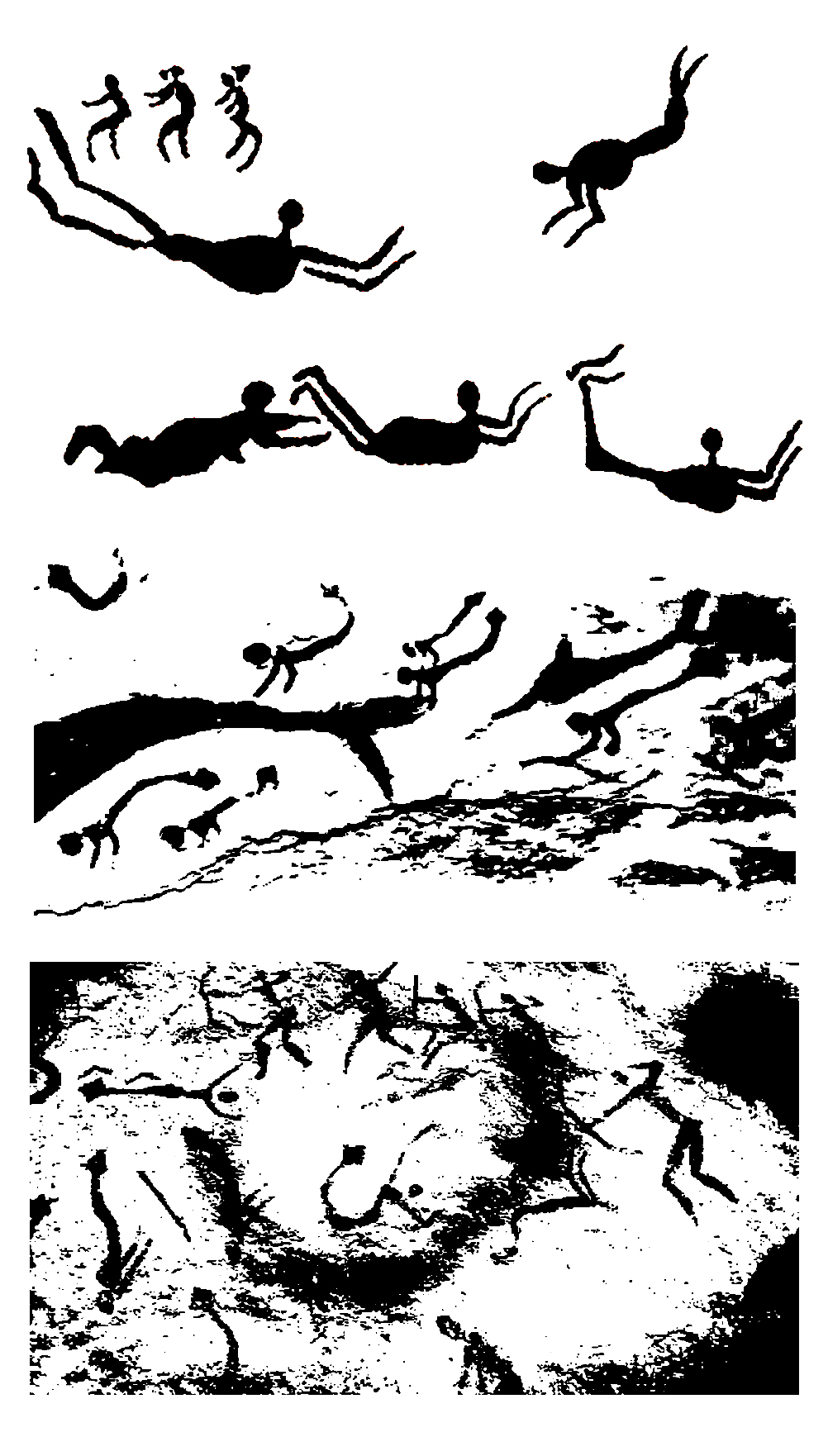
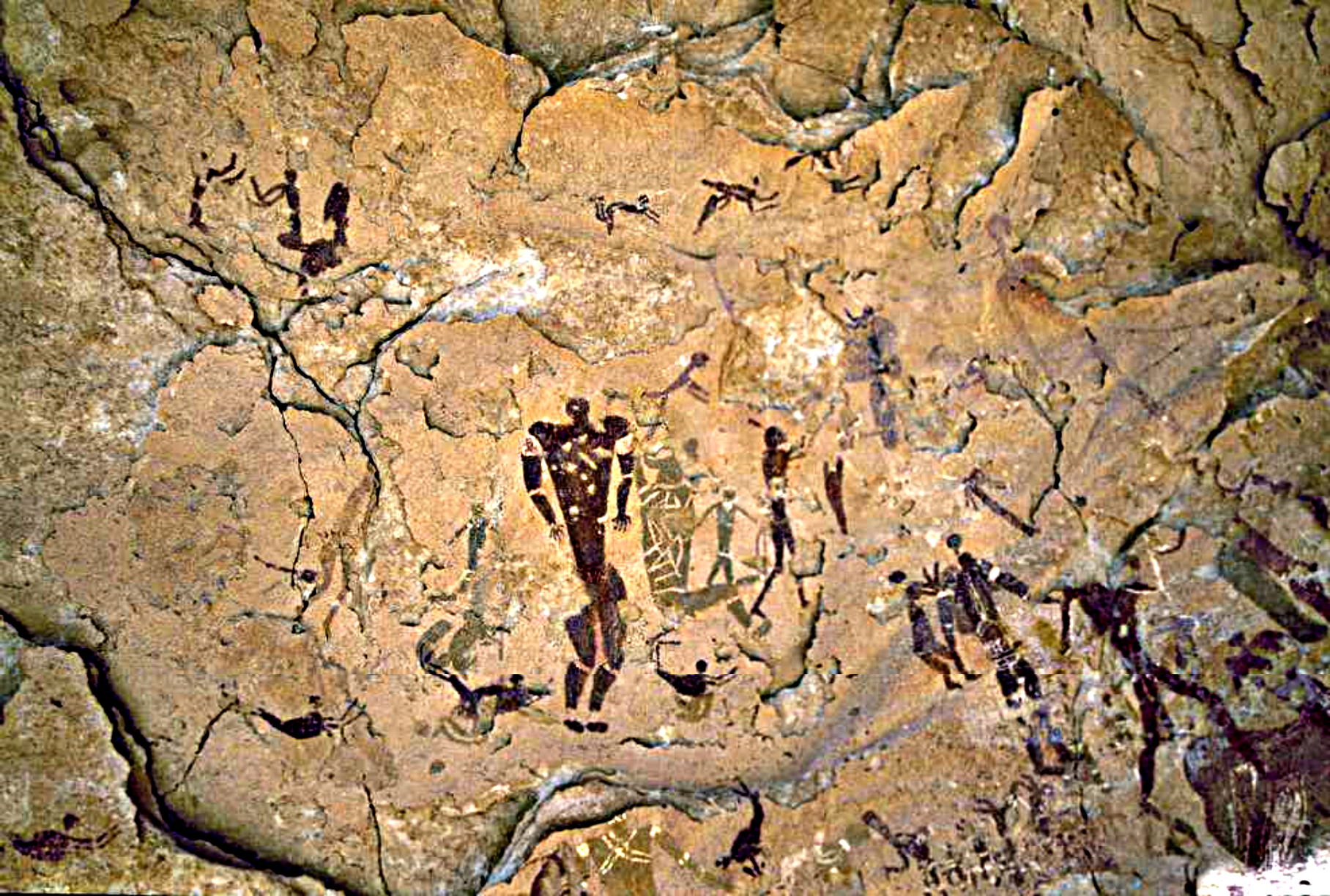
︎ The Cave of Swimmers’, Wadi Sura, Sahara.
Dated to 9,000 years old, the cave paintings show humans interacting with half human half fish people, suggesting to some that this region of the Sahara once had an abundant water source.
Dated to 9,000 years old, the cave paintings show humans interacting with half human half fish people, suggesting to some that this region of the Sahara once had an abundant water source.
Further Reading ︎
Full article written by Ventral is Golden & originally published in Wild Alchemy Journal.
Primal Wisdom of the Ancients: The Cosmological Plan for Humanity, Laird Scranton.
Children of the Dog Star, James Dorsey, article.Sound waves reveal diamond cache deep in Earth’s interior, article. Hydrous mantle transition zone indicated by ringwoodite included within diamond, article. Cave of Swimmers, article.
Full article written by Ventral is Golden & originally published in Wild Alchemy Journal.
Primal Wisdom of the Ancients: The Cosmological Plan for Humanity, Laird Scranton.
Children of the Dog Star, James Dorsey, article.Sound waves reveal diamond cache deep in Earth’s interior, article. Hydrous mantle transition zone indicated by ringwoodite included within diamond, article. Cave of Swimmers, article.